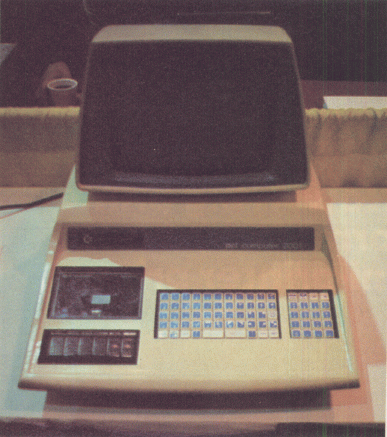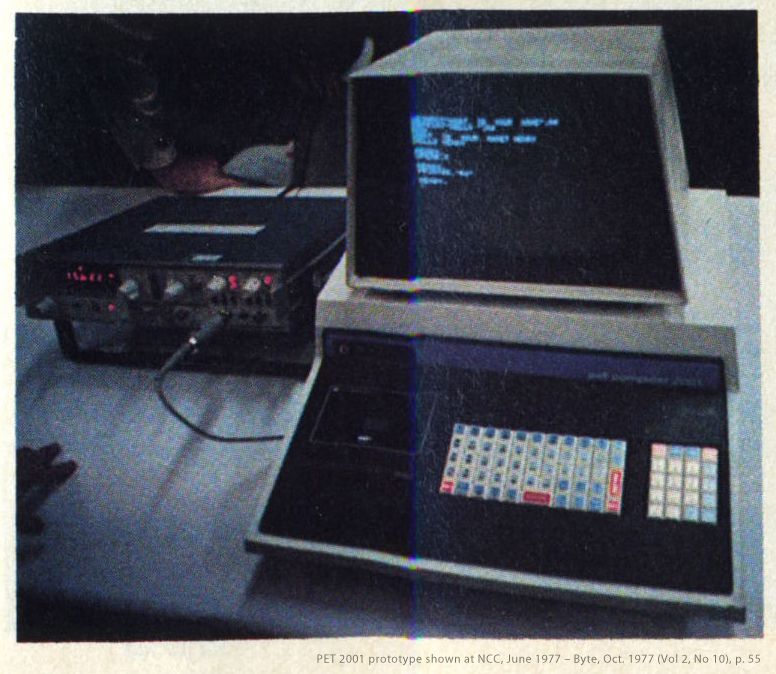A New Purpose
After Commodore bought out MOS Technology to make chips by their own manufacturing costs, they resold the KIM-1 under
their brand. Commodore CEO Jack Tramiel was convinced by newly-acquired engineer and MOS 6500-chip leader Chuck Peddle
that calculators were not profitable anymore, as Texas Instruments began selling their own whole calculators for less
than their chips when companies began using cheaper-to-produce CMOS chips and cut into TI's sales. Peddle recommended
Commodore go into the fledgling microcomputer industry. They initially decided on buying hardware from someone else. Apple
Computer founders Steve Jobs and Wozniak demonstrated a prototype of their upcoming Apple II in September 1976, but
Commodore backed out due to its high price. So, Tramiel instructed a team comprising of Chuck Peddle, Bill Seiler, John
Feagans, Jack's own son Leonard, and Japanese engineers Fujiyama and Aoji to build a computer prototype from the ground up
by Winter CES in January. (I should mention the prototype had slight cosmetic changes with each showing just before and
after release, so it's the same round-edged machine in each picture it appears in.)
The Prototype

The prototype was handmade with a wooden casing spray painted yellow to resemble painted metal and a monitor scavenged
from a cheap black-and-white television. When the design team discussed what to name the computer, Tramiel suggested
"PET" because of the "pet rock" fad of the last few years. Peddle felt there ought to be a meaning behind those three
letters, so the team settled on "Personal Electronic Transactor". Note the generic "pet computer 2001" label--that may
have been made before the late name choice.
PET is Born
The PET was shown at Winter CES of January 1977, and consumers were marveled by it. It booted up to a relatively complex
BASIC kernal which you could freely move a cursor, type, and backspace all over. The character ROM included graphical,
uppercase, lowercase, and reverse characters. Eventual competition by the Apple II and Tandy Radio-Shack TRS-80 wouldn't
even have lowercase for a couple years. The PET also came with a built-in cassette drive.

The curvy case style wouldn't stick around for long, as real PET computers were unveiled in June with sheet metal casing.
PET Comes Home

In October, the first 100 PETs were produced and released, going to magazines and software
developers. Some of them actually maintained the yellowish color of the original curvy prototype. A model with 4 KB and
another with 8 KB from the factory were made available.
PET's Oopsies
The original PET wasn't without its issues. The chiclet keyboard (so-called as the keys resembled 'chiclet gum') was way
too small and uncomfortable to type on. The labels on the keys were prone to rubbing away with users' fingertips. A minor
issue is that the PET had no compatible disk drive upon its release, while most competing machines did. Floppy disks
weren't made standard yet so cassette drives were still the medium of choice.
By early 1978, the 4 KB PET was discontinued to lighten up deliveries of back-ordered units. 4 KB wasn't even much for
1978, even factoring in the KERNAL taking about 900 B, leaving the user with 3 KB for BASIC programs. Speaking of,
Commodore gained a license from Microsoft to use their BASIC-80, resulting in the first version of Commodore BASIC.

Around the time the 4 KB PET was discontinued, PETs came out with a blue label and monitor
bezel and a different brand of cassette drive from the factory. This was also when 8 KB became the standard.
PET Grows Up
In 1979 after two years on the market, the Commodore PET evolved into a new line called the 2001-N's. At first, these new
machines used the same screen size as the earlier line, except with a green-phosphor display. It wasn't until slightly
later that models shipped with a bigger screen, and 16 to 96 KB of RAM and/or 80-column text. The exterior of the
N-machines were made of plastic, making them considerably lighter. These PETs used a business-specific BASIC 4.0, more
sophisticated than the cheaper 2.0 that the VIC-20 and 64 successors would have. Version 1.0 apparently had nonfunctional
IEEE support, along with a bunch of other bugs. Although, PET owners were given the option to upgrade to version 2.0.
The next couple years would see dozens of new PET models come out before the line ultimately ended around 1982.




